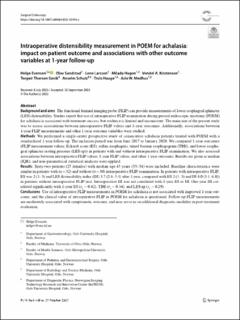| dc.description.abstract | Background and aims The functional luminal imaging probe (FLIP) can provide measurements of lower esophageal sphincter
(LES) distensibility. Studies report that use of intraoperative FLIP examination during peroral endoscopic myotomy (POEM)
for achalasia is associated with treatment success, but evidence is limited and inconsistent. The main aim of the present study
was to assess associations between intraoperative FLIP values and 1-year outcomes. Additionally, associations between
1-year FLIP measurements and other 1-year outcome variables were studied.
Methods We performed a single-center prospective study of consecutive achalasia patients treated with POEM with a
standardized 1-year follow-up. The inclusion period was from June 2017 to January 2020. We compared 1-year outcomes
(FLIP measurement values, Eckardt score (ES), reflux esophagitis, timed barium esophagogram (TBE), and lower esopha-
geal sphincter resting pressure (LES-rp)) in patients with and without intraoperative FLIP examination. We also assessed
associations between intraoperative FLIP values, 1-year FLIP values, and other 1-year outcomes. Results are given as median
(IQR), and non-parametrical statistical analyses were applied.
Results Sixty-two patients (27 females) with median age 45 years (35–54) were included. Baseline characteristics were
similar in patients with (n = 32) and without (n = 30) intraoperative FLIP examination. In patients with intraoperative FLIP,
ES was 2 (1–3) and LES distensibility index (DI) 3.7 (2.6–5.4) after 1 year, compared with ES 2 (1–3) and DI 4.0 (3.1–6.8))
in patients without intraoperative FLIP (ns). Intraoperative DI was not correlated with 1-year ES or DI. One-year DI cor-
related significantly with 1-year ES (rs − 0.42), TBE (rs − 0.34), and LES-rp (rs − 0.29).
Conclusions Use of intraoperative FLIP measurements in POEM for achalasia is not associated with improved 1-year out-
come, and the clinical value of intraoperative FLIP in POEM for achalasia is questioned. Follow-up FLIP measurements
are moderately associated with symptomatic outcome, and may serve as an additional diagnostic modality in post-treatment
evaluation. | en_US |

